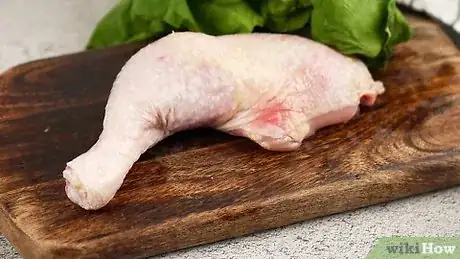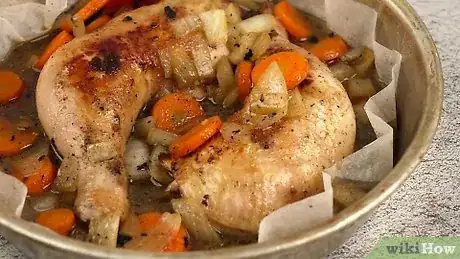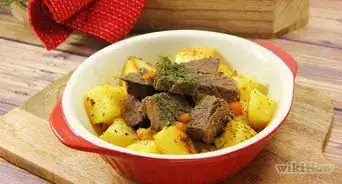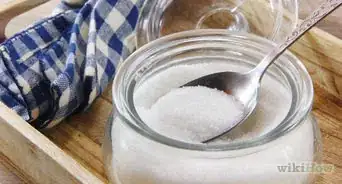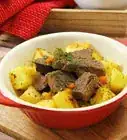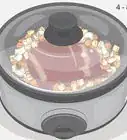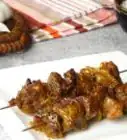This article was co-authored by Ollie George Cigliano. Ollie George Cigliano is a Private Chef, Food Educator, and Owner of Ollie George Cooks, based in Long Beach, California. With over 20 years of experience, she specializes in utilizing fresh, fun ingredients and mixing traditional and innovative cooking techniques. Ollie George holds a BA in Comparative Literature from The University of California, Berkeley, and a Nutrition and Healthy Living Certificate from eCornell University.
There are 12 references cited in this article, which can be found at the bottom of the page.
This article has been viewed 42,496 times.
Braising is a cooking technique that allows tougher and usually less expensive meats to become tender and juicy. Braising is the process by which meats are cooked in a savory liquid that provides a moist cooking environment. Cooking with this method will cause the connective tissues in tough cuts of meat to break down, resulting in moist, tender meat.
Steps
Preparing to Braise
-
1Choose the meat. Braising is a great technique for tough and inexpensive meat. When selecting a meat, don't choose tender or quality cuts. Cuts of meat with the bone in also work well for braising.[1]
- Braising beef works well with: chuck pot roast, shoulder steak, short ribs, rump roast, round steak, and brisket.
- Braising pork works well with: chops, cutlets, cubes, pork shoulder, Boston butt, sirloin roast, and ribs.
- Lamb shanks and shoulders are great for braising.[2]
- For chicken, try legs and thighs. Keep the bone in to get the fat and tissue; don't braise boneless chicken breasts.
- Try braising large, firm fish fillets, like shark, swordfish, or tuna. Don't braise tender fish like tilapia and cod. It'll fall apart.
- Don't limit yourself to meat. You can also braise fruits and vegetables. Go for firmer vegetables, like squash, sweet potatoes, leeks, carrots, beets, and cabbage.[3]
-
2Choose a liquid. Part of the braising process is cooking the meat for a long time in a liquid. Be creative with the liquids you choose. There is no right or wrong liquid to use. Think about the flavor palette you want to create, what flavors will go well with your meat, and what flavors will go well with the seasonings and vegetables.
- Try beef, chicken, or vegetable broth. You can also use stock. Try to match the meat with the broth or stock.
- Use wine or beer. For pork, try lighter lagers, which will give the meat a nice sour taste.[4] Try imported stouts or dark lagers for beef. Wine gives the dish a bit of an acidic taste. Stick with a dry wine and one that you would drink.[5] For a variety of flavor, mix your wine with your broth. You can also try balsamic vinaigrette.[6]
- For something a little sweeter, try apple juice, cranberry juice, orange juice, or pineapple juice. Use tomato juice for something a little more tart.[7] Ciders, fresh or fermented, go really well with poultry and pork for a bit of sweetness.[8]
- Use water for the liquid if your meat, seasonings, and vegetables have strong flavors.
- You can even braise with milk.[9]
Advertisement -
3Decide on the seasonings. Like liquids, the seasonings you choose can be creative and exciting. Match the herbs and spices to the liquid to make a complimentary flavor palette. You can use dried or fresh herbs when braising.
- Try basil, Italian seasoning, oregano, mint, or thyme. Sage, rosemary, dill, bay leaves, and cilantro can also be used. Salt and pepper can also be added.
- Garlic and onions are great flavorful additions to your braising liquid.
- Try capers, lemon zest, lime zest, or orange zest.[10] For something a bit sweet yet spicy, go for ginger. Lemongrass also adds a nice citrus sweetness to the dish.[11]
- For something spicier, try chili powder, peppers, cayenne pepper, or any other spice. Throw in some cumin and turmeric for an Indian flavor.[12]
- You can also try liquid seasonings, like barbecue sauce, Dijon mustard, soy sauce, steak sauce, Worcestershire sauce, duck sauce, or sweet chili sauce.
-
4Cook in the correct pot. No matter what meat you are braising, you need a large, deep heavy pot with a tight lid.[13] This keeps the moisture in, which is required to braise properly.
-
5Finish with vegetables. When you braise meat, you don't just add meat, but vegetables, too. Classic choices are onion, carrots, and celery. However, you can add just about any vegetables you want. Just remember to match your flavor palette.
- Try mushrooms. They give your dish a woodsy flavor.[16]
- Potatoes and sweet potatoes make a great addition that will turn the braised meat into a full meal.
- Try different variations of squashes, parsnips, turnips, rutabaga, or other root vegetables.
- Any kind of onion is a great addition to a braise.[17]
Braising the Meat
-
1Prepare the meat. Preheat the oven to 350 degrees. While the oven is heating, season the meat with salt and pepper and any other seasonings you desire. Trim any excess fat from the meat.[18]
- Keep the chunks of meat large. Try to keep the edges smooth instead of ragged, and don't pierce the edges. Smooth edges with no pierced places helps to absorb and keep the juices in.[19]
- If the cut of meat you're using has a bone, then there may be tiny bone chips left behind. To remove, carefully run the meat under warm running water, rubbing it gently to dislodge any bone chips. Then, dry the meat with a paper towel and season it .
-
2Sear the meat. Place 2 tablespoons of oil in a pot over medium-high heat. When the oil is hot and rippling, add the meat allowing it to brown in the oil. Then turn it to an unbrowned side. Continue in this fashion until the meat is browned all over. Set the meat aside when it's finished browning.
- Make sure your pan is very hot. If the pan is smoking, that is a good thing. It should also be uncovered. Just make sure you open a window or use your exhaust fan.[20]
- As you are browning, look for the outside to get caramelized and crispy.[21] Remember, you aren't cooking the meat, just searing the outside.
- Don't crowd your pot. Make sure there is enough room for the meat so it can properly sear.[22]
-
3Sauté the vegetables. Add any combination of vegetables to the hot pan. Allow the vegetables to cook quickly until they're browned on the outside and fragrant. This should take 3 or 4 minutes.
- Sauté the vegetables until they are a caramel brown color. Stir them often to keep them from searing.[23]
-
4Deglaze the pan. Caramelized brown bits should be left on the bottom of the pan. Pour in a splash of your liquid while still on medium heat. Then, use a wooden spoon to remove the caramelized bits from the bottom of the pan. You want to keep these brown bits because they add to the flavor.[24]
-
5Combine the ingredients. Place the meat back in the pot with the vegetables. Add the braising liquid so that it comes up to about halfway up the meat. Bring to a boil, then decrease the temperature so the dish can simmer.[25]
- Once the dish is simmering, add the seasonings.
- Don't add too much liquid. The meat shouldn't be completely covered by the liquid. Instead, only fill it so the meat is halfway covered. If you add too much liquid, it can decrease the flavor.[26]
- If the pan you seared your meat and vegetables in isn't suitable for the oven, place the ingredients in another dish, such as a crock pot or oven-safe casserole dish. Add the vegetables and deglazing liquid.
-
6Cook the meat. Tightly cover the pot with the lid. Place the pot in the oven at 350 degrees. Cook for 1.5-6 hours. You want to cook the meat until it is tender and falls apart with a fork. Don't overcook, because then the meat will become dry.[27]
- You can cook anywhere between 250-350 degrees.
- If cooking on the stovetop, set the heat to low. A crockpot should be set to high.
-
7Finish the dish. If you want to add more vegetables, add them 45 minutes before the meat is done. Add a bit more liquid if it's lower than an inch.
- If you want to make a sauce or gravy, remove the meat and vegetables when the meat is fork-tender. Skim off the surface fat. Allow the sauce to simmer so it can reduce down until it coats the back of your spoon. Return the meat and vegetables to the pot and heat.[28]
- To make a thicker sauce, try adding flour or cornstarch.
- Let the meat sit in the sauce for 10-20 minutes after you take it out of the oven. This helps the juices absorb into the meat.[29]
Expert Q&A
-
QuestionWhich is the best cooking method for a pork shoulder?
 Joshua & Jeremy GeorgeJoshua and Jeremy George are BBQ Specialists and the Co-Owners of Smokin J’s BBQ in San Diego, California. With over six years of experience, they specialize in slow-smoked meats and making in-house rubs and sauces. Smokin J’s BBQ has been featured in many publications, including The BBQ Magazine.
Joshua & Jeremy GeorgeJoshua and Jeremy George are BBQ Specialists and the Co-Owners of Smokin J’s BBQ in San Diego, California. With over six years of experience, they specialize in slow-smoked meats and making in-house rubs and sauces. Smokin J’s BBQ has been featured in many publications, including The BBQ Magazine.
BBQ Specialists Cook pork shoulder for a long time with low heat—this helps the meat stay tender. You don't want to use high heat; otherwise, the outside will get overcooked (or possibly burned) before the inside comes to temperature.
Cook pork shoulder for a long time with low heat—this helps the meat stay tender. You don't want to use high heat; otherwise, the outside will get overcooked (or possibly burned) before the inside comes to temperature. -
QuestionHow many minutes do you braise lamb?
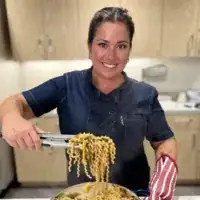 Ollie George CiglianoOllie George Cigliano is a Private Chef, Food Educator, and Owner of Ollie George Cooks, based in Long Beach, California. With over 20 years of experience, she specializes in utilizing fresh, fun ingredients and mixing traditional and innovative cooking techniques. Ollie George holds a BA in Comparative Literature from The University of California, Berkeley, and a Nutrition and Healthy Living Certificate from eCornell University.
Ollie George CiglianoOllie George Cigliano is a Private Chef, Food Educator, and Owner of Ollie George Cooks, based in Long Beach, California. With over 20 years of experience, she specializes in utilizing fresh, fun ingredients and mixing traditional and innovative cooking techniques. Ollie George holds a BA in Comparative Literature from The University of California, Berkeley, and a Nutrition and Healthy Living Certificate from eCornell University.
Private Chef & Food Educator Lamb shanks weighing 0.5 to 1 pound (0.2 to 0.45 kg) should be braised for 1.5 to 2 hours until the internal temperature reaches 160°F (71°C) on a meat thermometer.
Lamb shanks weighing 0.5 to 1 pound (0.2 to 0.45 kg) should be braised for 1.5 to 2 hours until the internal temperature reaches 160°F (71°C) on a meat thermometer.
Expert Interview

Thanks for reading our article! If you'd like to learn more about cooking, check out our in-depth interview with Ollie George Cigliano.
References
- ↑ http://www.bonappetit.com/test-kitchen/cooking-tips/article/how-to-braise
- ↑ http://www.bhg.com/recipes/how-to/cooking-basics/how-to-braise-meat/
- ↑ http://www.reluctantgourmet.com/how-to-braise-everything/
- ↑ http://www.bonappetit.com/test-kitchen/cooking-tips/article/four-simple-rules-for-braising-anything
- ↑ http://www.bhg.com/recipes/how-to/cooking-basics/how-to-braise-meat/
- ↑ http://www.reviewjournal.com/life/fooddining/want-learn-how-braise-meat-check-out
- ↑ http://www.bhg.com/recipes/how-to/cooking-basics/how-to-braise-meat/
- ↑ http://www.bonappetit.com/test-kitchen/cooking-tips/article/four-simple-rules-for-braising-anything
- ↑ http://www.bonappetit.com/test-kitchen/cooking-tips/article/how-to-braise
- ↑ http://theeverygirl.com/cooking-101-how-to-braise-meat
- ↑ http://www.bonappetit.com/test-kitchen/cooking-tips/article/four-simple-rules-for-braising-anything
- ↑ http://www.bonappetit.com/test-kitchen/cooking-tips/article/how-to-braise
- ↑ http://www.thekitchn.com/word-of-mouth-b-1-19631
- ↑ http://www.cookingchanneltv.com/how-to/how-to-braise-meats.html
- ↑ http://theeverygirl.com/cooking-101-how-to-braise-meat
- ↑ http://www.bonappetit.com/test-kitchen/cooking-tips/article/four-simple-rules-for-braising-anything
- ↑ http://www.bhg.com/recipes/how-to/cooking-basics/how-to-braise-meat/
- ↑ http://www.bhg.com/recipes/how-to/cooking-basics/how-to-braise-meat/
- ↑ http://www.thekitchn.com/word-of-mouth-b-1-19631
- ↑ http://www.huffingtonpost.com/trish-santoro/how-to-braise-meat-like-a-professional-chef_b_6306182.html
- ↑ http://www.reviewjournal.com/life/fooddining/want-learn-how-braise-meat-check-out
- ↑ http://www.bonappetit.com/test-kitchen/cooking-tips/article/four-simple-rules-for-braising-anything
- ↑ http://www.bonappetit.com/test-kitchen/cooking-tips/article/four-simple-rules-for-braising-anything
- ↑ http://www.bonappetit.com/test-kitchen/cooking-tips/article/how-to-braise
- ↑ http://www.foodnetwork.com/how-to/articles/how-to-braise-meats-a-step-by-step-guide.html
- ↑ http://www.reviewjournal.com/life/fooddining/want-learn-how-braise-meat-check-out
- ↑ http://www.reviewjournal.com/life/fooddining/want-learn-how-braise-meat-check-out
- ↑ http://www.bonappetit.com/test-kitchen/cooking-tips/article/four-simple-rules-for-braising-anything
- ↑ https://www.finecooking.com/article/give-it-a-rest-why-some-dishes-taste-better-with-time
- ↑ http://www.dummies.com/how-to/content/how-to-braise-meat.html
About This Article
To braise meat, start by searing each side of the meat in a pan over medium-high heat. Then, transfer the meat to large pot and pour in broth, beer, juice, or water until the liquid covers half of the meat. Next, bring the liquid in the pot to a boil. Once the liquid is boiling, cover the pot and place it in the oven. Cook the meat for 2-6 hours at 350 °F, or until it's tender. For more tips, including how to choose the best meat for braising, read on!
